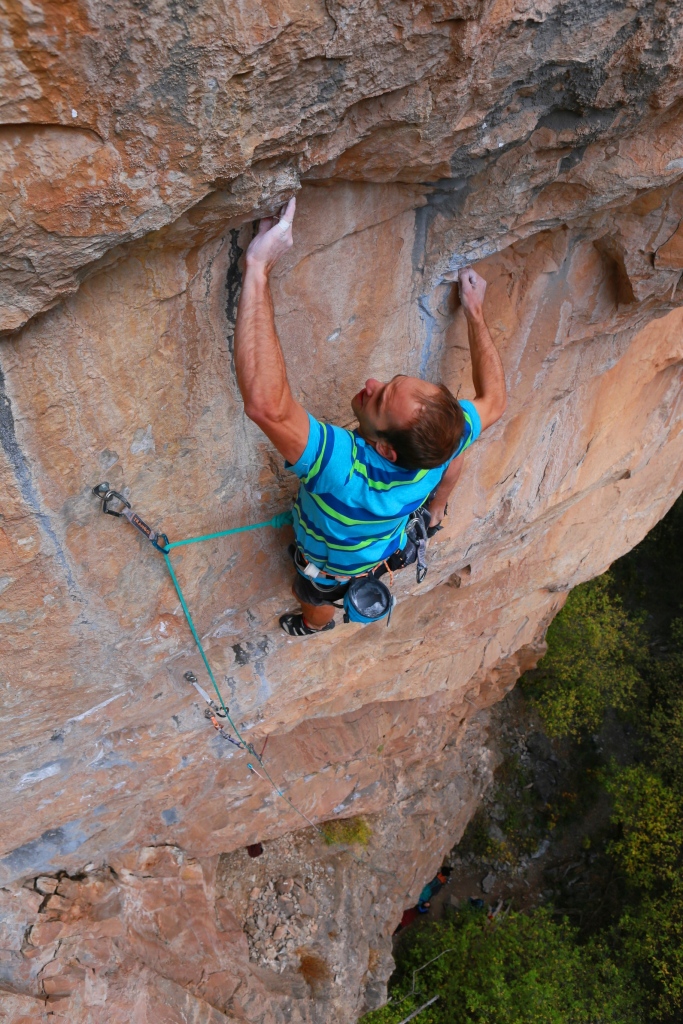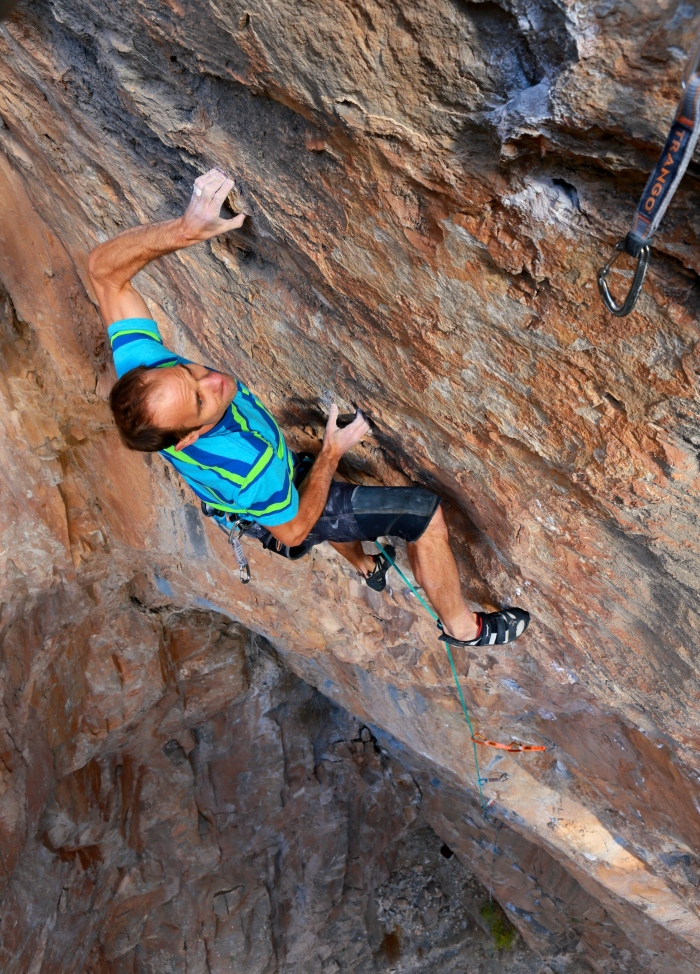By Mark Anderson
This is the third installment in a multi-part series about my training for Shadowboxing. For the first installment click here. For the second installment click here.
Visualization is an important part of any hard ascent, but the picture in our mind is often overly idealized. We imagine everything going flawlessly—executing the sequence perfectly, in optimal weather conditions, feeling fantastic the entire time. I do this because I doubt I have enough margin to scrap my way up the climb, instead thinking that if I’m going to do it, every factor will have to converge perfectly. Conversely, professional coaches and athletes in major sports often speak of overcoming adversity, such as unfair officiating, weather that doesn’t favor their game plan, or unlucky bounces. I thought about that a lot through the long winter, and tried to prepare myself mentally for the hurdles I knew I would face (such as poor conditions), plus others I wasn’t anticipating. I needed to be prepared to roll with the punches, rather than fold the first time something didn’t go my way.
If you asked me at the end of May, I would probably say that I failed miserably in this endeavor. At least, I failed to anticipate the scope of my trials. It started with a bout of the flu that hit at the worst possible moment: three days before I was set to get back on the route for the first time in seven months. I was reduced to oblivion for 60-straight hours, and feeble and woozy for four days after. This resulted in a day of lost training and two sub-par days on the route, but more importantly, about a 10% reduction in strength and power that I was never able to recover. The next blow was seeping rock that was much worse than I anticipated. When I first returned in May roughly 1/3 of the holds in the lower half of the route were wet. Not that it mattered–I was so wrecked from the flu I was lucky to link ten moves in a row that first weekend!
The next weekend went much better. But when I climbed up into the crux the first day of the third weekend I discovered a key undercling was totally gone. The rest of that day was devoted to re-solving that section. The final straw was tweaking my back while rolling over in bed that night (one of the many perils of aging). It was beginning to feel like the season was cursed–I was half-way through it and I hadn’t even matched my Fall highpoint on the route. I summarized my mindset at the end of the weekend thusly:
“Way not psyched at end of day. Felt like I had so much promise heading into Friday, and then the broken hold took the wind out of my sails, and then again, after that was resolved, tweaked back was the next blow. Depressed and searching for motivation. Trying to wrap my head around the idea that I’m unlikely to send this season.”
Unfortunately that wasn’t my low point. Over the next two days I waffled constantly about whether or not to continue on the route. June was imminent, and I expected the temperatures to sky-rocket at any time. Was it helpful to keep at it when I wasn’t making progress? Even if sending this season was unlikely, would continuing on the route improve my chances of success in the upcoming Fall, or was I just training myself to fail, wrecking my confidence and killing my motivation? This all came to a head during my weekly indoor training session at the end of May.
By this point I was using Non-Linear Periodization to maintain Strength and Power while emphasizing Power Endurance (PE) training, by following this program:
- Warm-up:
- 10-min ARC on 10-35 degree overhangs
- 10 min Warm-up Boulder Ladder (including V2, V3, V4, V5, V7, V8)
- Limit-Bouldering (25-35 minutes*, including sending up to V11 and attempting up to V12)
- Campusing (25-35 minutes*, beginning with 1-3-5-7 and working up to Max Ladders)
- Linked Bouldering Circuit (Attempt 4 sets of 52-move Extended Green Traverse, reducing Rest Between Sets from 4:00 to 90 seconds)
- Supplemental Exercises, ~30 min total/2-3 sets of:
- Advanced 1-Arm Rows/1-Arm Pull-ups/Explosive Pull-ups
- Front Levers
- Biceps Curls
- Lateral-to-Front Raise
- Shoulder Press
- Wings
- Ab Rolls from Rings
- Rotator Cuff Exercises with Theraband
[* Varied such that the total time, including warm-up, LBing and Campusing are limited to ~80 minutes]
In general, my PE training was progressing nicely, picking up where I left off in March. I continued to attempt 4 sets of my new 52-move circuit, starting with 4:00 rest-between-sets, and reducing it as the season progressed. However, my power training went from phenomenal to dismal after the flu. I was never able to recover my power since my weekend forays on the route were too taxing to allow for sufficiently intense mid-week indoor sessions (in retrospect, it may have been wise to delay my outdoor climbing in order to re-hone my power after the flu, but at the time I felt pressed for time with summer heat a few weeks away).
On that last day of May, my bouldering and campusing were particularly poor, and I ended both segments much earlier than planned. At that moment I was ready to abandon the rest of the season. I went for a short walk, weighing the pros and cons. I decided there was no advantage in quitting at that moment—I could use the PE training either way, so I should at least complete that part of the workout. I went on to have my best PE session ever, sending the first three sets of my 52-move circuit with 2:30 rest between sets (roughly a 1:1 duty cycle). That was enough to re-kindle my psych. I decided I should go out for at least one more weekend.
The first day of that trip I finally exceeded my Fall 2015 high point, and on the next climbing day I got my first one-hang, falling at the Crimp Crux. I matched this new highpoint on the next go. That day the rock was completely dry for the first time that season, which certainly helped, but the biggest factor was that my endurance was significantly better. Overall my May/June PE training went better than expected. During my last PE workout of the season I sent the first three laps of my 52-move circuit with only 2:00 rest-between-sets. I was certain my experiments and efforts over the winter had paid off, and my endurance had reached a new level—sufficient to send the route. Unfortunately I learned that PE alone was not enough. Although I managed to one-hang the route four more times, I found myself falling more and more often on a powerful dyno in the lower third of the climb. My endurance was at an all-time best, but my Power Peak was long gone. By mid-June it seemed I was stagnating (if not regressing) on the route. The forecast predicted a steady 10-15 degree temperate hike, so I decided to end my season.

I never fell on this powerful dyno in the first half of the May/June 2016 season, but by mid-June I was falling on it regularly—a clear sign of waning power. Photo Mike Anderson.
I was disappointed that I didn’t send, and I still wonder if I made the right call, throwing in the towel when I was arguably quite close. It’s hard to know and easy to second guess. To be fair, I think a younger, less-determined me would have retreated much earlier, prior to achieving the 1-hang that re-kindled my motivation. Had I quit during that workout at the end of May, I might have never come back to the route. In retrospect, I think preparing myself for some adversity prior to the start of the season allowed me to persevere long enough to squeeze out every last drop of adversity that frustrating canyon has to offer. When I returned in September 2016 it had nothing left to give me–I had already taken all of Rifle’s best shots. Furthermore, the consistent one-hangs I earned in June were crucial to motivating my training over the summer. I had learned how to develop the necessary endurance to link the route. I had learned that I was capable of sending, even in sub-optimal conditions. I just needed to better time my power and fitness so the two converged simultaneously. Orchestrating that would be the focus of the long hot summer.



Interesting, and a bit surprising, to hear how close you came to simply passing on the route altogether. Why so many doubts?
LikeLike